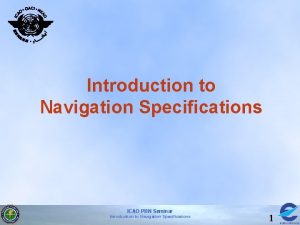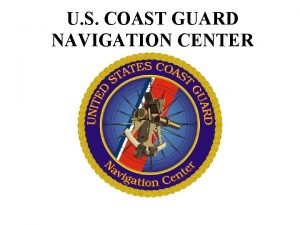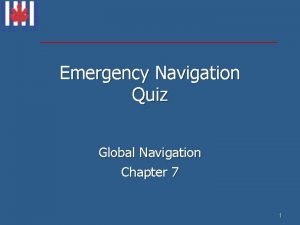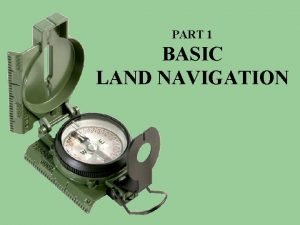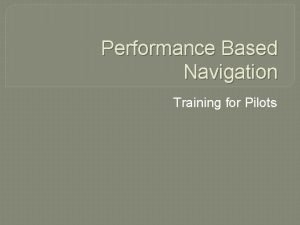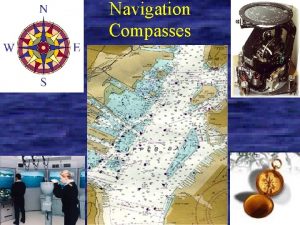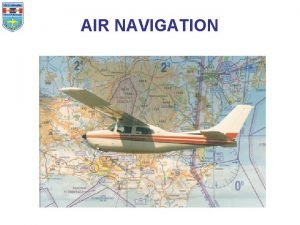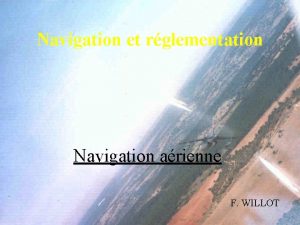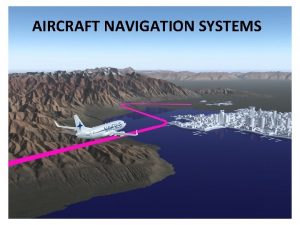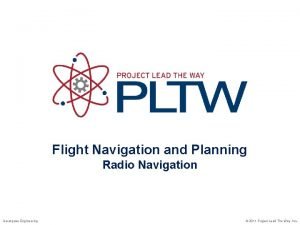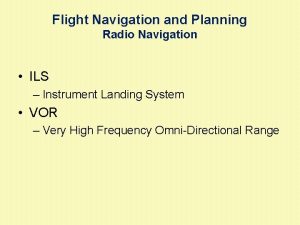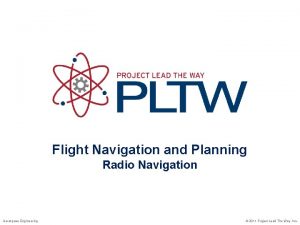1 2 Methods of Radio navigation Radio navigation









![v = [(Xp-Vt)² + Y²p]1/2 r = ½r [2(Xp-Vt) (-v)] = - 1 r v = [(Xp-Vt)² + Y²p]1/2 r = ½r [2(Xp-Vt) (-v)] = - 1 r](https://slidetodoc.com/presentation_image_h2/3b1b39d356a5729b711acd52cd5de3a5/image-10.jpg)





- Slides: 15

1. 2 Methods of Radio navigation § Radio navigation provides is position estimate, also called position fixes, with which we fix our inertial navigation position estimates. § The development of radio navaids accelerated during and after world II resulting in VHF Omni directional Radio Range (VOR) Tactical Air Navigation (TACAN) Instrument Landing system (ILS) Microwave landing system (MLS) These are ground – based, short – range , lines – of – sight systems

1. 2. 1 Trilateration The coordinates of P (X, Y) are unknown The coordinates of Sk (Xk, Yk) are known, or P is informed about it. The electromagnet waves travel at a known speed c (3 X 10⁸ m/s) If the transit ∆t k = [(Xk – X)² + (Yk – Y)²]½ (1. 1)

v Estimation of position based on measurement of distances (ranges) is referred to as trilateration. v Trilateration is a Time – of – Arrival (TOA) system, become we measure ∆tk = t arrival, k – t transmission, k ∆Tk could be measured if both transmission, k and arrival, k are known to the receiver. v How many transmitters are required to determine P (X, Y) ? Just one (K=1) gives a circle of radios r 1 called line – of – position Two ( K = 1, 2) give two circle of radius r 1 and r 2 with two points of intersection. sono unique soln.

Three (k = 1, 2, 3, ) give a unique P(X, Y) see the numerical example. v k = 1, 2 [i. e. two transmitters] would suffice if some approximate location of P(X, Y) is known in advance, which is usually the case. v For 3 – dim position estimation, we need a transmitter that should be up above at some air borne or space – based signals for 3 – din position estimation. v Synchronization of the clocks of the in order to measure ∆tk (k = 1, 2, 3) correctly, the clock of the transmitters, receivers must be synchronized. Otherwise, for c = 3 X 10⁸ m/s a synchronization error of 1 ms = 3 X 10⁸ X 10–⁶ m = 300 m error of 1 ms = 3 X 10⁸ X 10 –⁹m = 30 cm

v The transmitters can be synchronized, but impractical to expect synchronization with the receiver clock. So, have one more transmitter to determine the receiver clock error.

1. 2. 2 hyperbolic positioning § These system are based on the measurement of the difference in the times of arrival of signals from two transmitting stations. § The transmitters are synchronized, but the receiver need not be and its synchronization error, if some, does not matter because we measure the difference in the times of arrival. § Such system are called Time – difference – of – Arrival (TDOA) systems. § Loran (long range navigation) is such a system. § Omega, the first truly global radio navigation system, now discontinued, was also a TDOA system.

• The basic idea for 2 -dim is as follows: r₁= [(X₁-X)² + (Y₁-Y)²]½ = c∆t₁ r₂= [(X₂-X)² + (Y₂-Y)²]½ = c∆t₂ r₃= [(X₃-X)² + (Y₃-Y)²]½ = c∆t₃ Difference in the times of arrival at P of the signals from S₁and S₂: ∆t₂ - ∆t₁ We may just as well consider: r₂₁≜ c(∆t₂- ∆t₁) = r₂- r₁= [(X₂-X)² + (Y₂-Y)²] ½ - [(X₁-X)² + (Y₂-Y)²] ½ Likewise : r₃₁= c (∆t₃- ∆t₁) = r₃- r₁= [(X₃-X)²] ½ - [(X₁-X)² + (Y₁-Y)²] (1. 2 a) (1. 2 b)

Fig 1. 6 Hyperbolic position § The hyperbola X₃ is the locus of points that are 3 units closer to transmitter X than to the transmitter m: rm = rx = 3 u Or rm = uu, rx = u so that rm – rx = 3 u rm = 5 u, rx = 2 u so that rm – rx= 3 u rm = 3. 14, rx = 0. 1 u, so that rm – rx = 3 u # Likewise, draw the hyperbola X₂, X₀, X₋₁, X₋₂, X₋₃, . . . # The hyperbole Yi are defined for the rair of transmitters m and y. # The intersection of the hyperbole Xi and Yj yields the location of the receiver P # The multiple solutions are resolved by the prior knowledge of some approximately location

1. 2. 3 Doppler Positioning § Doppler effect is the change in the apparent frequency of a signal received by an observe due to relative motion between a transmitter and the observer § Doppler shift is the difference between the frequency of the received signal and the frequency at the source. § The first satellite navigation system, called Transit, was based on the measurement of Doppler shift. § This technique of positioning is called Doppler shift. § One – dim positioning
![v XpVt² Y²p12 r ½r 2XpVt v 1 r v = [(Xp-Vt)² + Y²p]1/2 r = ½r [2(Xp-Vt) (-v)] = - 1 r](https://slidetodoc.com/presentation_image_h2/3b1b39d356a5729b711acd52cd5de3a5/image-10.jpg)
v = [(Xp-Vt)² + Y²p]1/2 r = ½r [2(Xp-Vt) (-v)] = - 1 r [2(Xp-Vt) =-V cos ө r

§ As the locomotive approaches P, more cycle of waves are read. At P than transmitted by the locomotive because of shrinking r, and the pitch of the sound heard seems higher, the apposite is true when the locomotive recedes. § The transmitted freq. , ƒT (1 -r ) Vs Vs = speed of propagation of the waves = λƒT r = the component of V along r So the Doppler shift =ƒR – ƒT = - r ƒT = + V cos ө ƒT Vs Vs

ƒR – ƒT = V cos ө = - r (1. 4) λ λ What we measure is Doppler shift = ƒR - ƒT → λ (ƒR – ƒT) = - r § See the illustration, fig. 1. 7, and elaborate. § The shape of the Doppler shift curve determines the observers distance from the track. § Navigation with Transit Satellites

§ Four to seven satellite in low – altitudes (1100 km), nearly circular, polar orbits § Each satellite broadcast signal at 150 -400 MHZ (VHF, UHF) § Only one satellite in view at a time § User waited 100 minutes between successive passes to determine position § After a satellite came in view, the Doppler shift of the received signal was recorded continuously § Navigation message from the sat. gives the position of the sat. § The satellite pass lasts 10 -20 minutes. § The receiver determines Doppler count:

= ∫ (ƒT-ƒR) dt ti -₁ ti ti = ∫ + r dt = +1 ∫dr λ λ ti -₁ Doppler count = + 1 [r( ti ) - r( ti-₁)] (1. 5) (1. 6) § The Doppler count is thus a direct measure of change in distance between the receiver and the satellite over a time interval. § For each Wavelength the satellite moves away, i. e. , r (ti) – r (ti -₁) =+λ, Doppler count goes up by 1; and vice versa

v Transit satellites were used by u. s. Submarines to update a ship’s position and reset the inertial now. v The 2 – D positioning accuracy : 25 m rms for a stationery user v Transit satellites were used between 1967 – 1996 v Than came along the GPS. For India, IRNSS v Doppler – based positioning is suitable for ships at sea which require infrequent updates , and could track a signal for 10 -20 minutes continuously during a satellite pass. Not suitable for airplanes.
 Fabrication of wax pattern
Fabrication of wax pattern Trunking vs conventional radio system
Trunking vs conventional radio system Pbn navigation specification
Pbn navigation specification Navigation taxonomies
Navigation taxonomies Sun stone navigation
Sun stone navigation Us coast guard navigation center
Us coast guard navigation center Navigation quiz
Navigation quiz Lensatic compass parts
Lensatic compass parts Gold, glory and god
Gold, glory and god Laser navigation
Laser navigation Navigation tool
Navigation tool Navigation performance scales
Navigation performance scales Gyro error
Gyro error Heading navigation
Heading navigation Performance based navigation
Performance based navigation What is terrestrial navigation?
What is terrestrial navigation?


